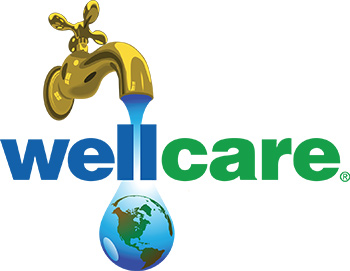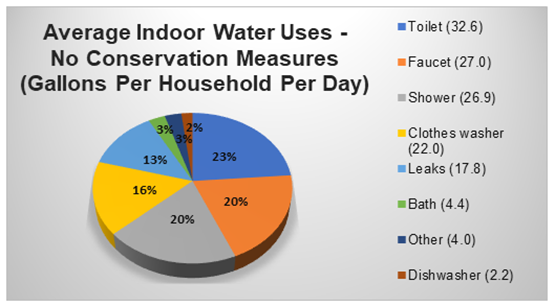This is a topic we cover regularly to stress the importance of water conservation because the truth is many areas are facing serious water shortages. Water is being used faster than it can be naturally replenished. You may be thinking, “I have a newer home with efficient water appliances I should not have to worry.” Not the case! New homes typically have more efficient fixtures and use less water, but they usually have more fixtures – bathrooms, garbage disposal, whirlpool tub, hot tub, or swimming pool – that consume greater quantities of water. This article is intended to help all well owners with all styles of homes take steps to reduce water use, safeguard their drinking water supply, save money, and protect the environment. Trust us, you do not want to wait until a prolonged drought or water shortage creates a water emergency like a dry well!
Average Water Use
The average family uses more than 300 gallons of water per day at home and 70 percent of this use occurs indoors. Efforts to reduce water consumption are especially important if you have a low yielding well (less than 5 gallons a minute), if you live in a drought region, or in an area of rapid development where groundwater supplies are strained. The following chart shows average indoor water uses with no conservation measures to help you make an informed decision on where you can save water! Keep an eye on the Drought Monitor map throughout the dry months.
Conduct a Household Water Audit
A household water audit is an evaluation of how much water is used and how much water can be saved. This is important for well owners since they do not have a water bill that provides this information. Conducting a water audit involves calculating water usage first. This Water Footprint Calculator can help. It is very thorough and upon completion, you can have the report emailed to you. You can compare your results with the chart above. Consider what the reasons may be for high levels of water use. Are fixtures leaking or are appliances old and inefficient? Or is it the way you use the water (e.g., long showers, half-full loads of laundry)? Continue your water audit by reading through the following simple ways to save water in and around your home.
Change Behavior
Small changes in behavior can also reap major benefits in water conservation and save money by reducing wear and tear on your well and septic system. Just think about the hundreds of gallons of water you are pumping from your well each day to your home. That water is then released from your home which goes to your septic system. These heavy uses will eventually cause expensive repair or replacement and exhaust groundwater resources. Limit demand by spreading out your daily and weekly water uses, such as bathing, watering the garden, and washing dishes or clothes. Remember, even seemingly small measures can save thousands of gallons of water per year. Try using some (or all!) these methods to save:
Inside
- Turn off the tap when brushing teeth, shaving, or scrubbing.
- Use the sink, not running water, to rinse your razor.
- Do not use the toilet as a wastebasket.
- Take shorter showers.
- Keep a pitcher of drinking water in the refrigerator rather than running the tap.
- Run the clothes washer and dishwasher only with full loads.
Outside
- DO NOT use your well to fill pools, hot tubs, or for other large uses. Use a water delivery service instead.
- Water during the coolest part of the day, preferably in the early morning, to reduce evaporation. Most established lawns and gardens need just one hour of deep watering once a week to remain healthy. Remember to water just the grass, not the pavement!
- Set the lawnmower to 3 inches. Longer grass allows less evaporation and shades the roots from drying out so quickly.
- In the garden, switch from sprinklers to soaker hoses.
- Look for native perennial plants and grass seeds at the garden center. These require much less water, particularly in drier climates than tropical annuals.
- Use mulch to retain water in the soil and reduce thirsty weeds.
- Fit all hoses with a sprayer to control flow.
- Use a broom, not a hose, to clear debris from sidewalks.
- Wash the car with soap and water from a bucket.
Continue reading our Water Conservation information sheet for additional measures you can take in and around your home.


